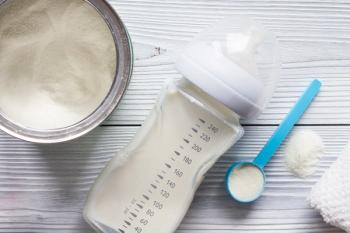
Toddlers consuming nearly as much sugar as older kids
A recent report reveals just how much sugar infants and toddlers are eating—and it’s not pretty.
Americans eat a lot of sugar—much of it hidden in the foods we eat. Not even children are immune. Research1 has shown that children consume far more added sugar than they should, and now a report reveals that nearly all children in the United States consume added sugars before age 2 years.
The
The CDC researchers found that in a nationally sample of more than 1200 children from birth to age two years, 98.3% of toddlers aged one to two years and 60.6% of infants up to age one year were fed added sugars. These sugars were mainly found in snacks, bakery and sweets, baby foods, yogurts, and fruit drinks.
Kirsten Herrick, PhD, MSc, now works at the National Cancer Institute but led the study while employed at the CDC’s National Center for Health Statistics. She says although the fact that added sugars are finding their way into the diets of infants and toddlers wasn’t surprising, just how much they are consuming should serve as a wake-up call for parents and pediatricians.
“Added sugars are everywhere in the US diet. So, it’s not surprising that US toddlers and infants are exposed to added sugars,” Herrick says. “What is surprising is how much they are consuming and how quickly consumption amounts reach amounts similar to those of older children.”
Generally, children under age two years should avoid added sugars altogether. The American Heart Association recommends no more than 6 teaspoons—or less than 25 grams—of added sugar daily for children aged 2 to 18 years. The CDC report, however, revealed that toddlers in the study consumed an average of 5.8 teaspoons each day whereas infants averaged just under a teaspoon.3
Not only can these added sugars lead to obesity and other health problems later in life, but they also fill the children up, leaving less appetite and less room in their diets for nutritionally dense foods. Consuming a lot of added sugars also trains their tastes for foods with a lot of sugar, the report cautions, setting poor dietary habits.
There were few demographic differences in the study group’s results by gender, parental income or education, or race for infants. For toddlers, there were some racial and ethnic patterns, with non-Hispanic white and non-Hispanic black children consuming the highest amounts of added sugars.
It’s easier than ever to spot added sugars, thanks to new regulations that require added sugars to be included on every Nutrition Facts panel as of January 2020, Herrick notes. Still, sometimes these labels can still be deceiving.
“Pediatricians can also help parents identify added or hidden sugars by reading the ingredients list and looking for different words used to refer to added sugars in products,” Herrick says.
The American Heart Association also offers a
“To tell if a processed food contains added sugars, you need to look at the list of ingredients,” Herrick explains. “Sugar as many other names. Besides those ending in ‘-ose,’ such as maltose or sucrose, other names for sugar include high fructose corn syrup, molasses, cane sugar, corn sweetener, raw sugar, syrup, honey, or fruit juice concentrates.”
The study authors note that a 2020 revision of the Dietary Guidelines for Americans will update with new advice for children under age 2 years. Herrick is hopeful the report will shine new light on the prevalence of added sugars the diets of infants and toddlers.
“My hope is that this work will raise awareness for both clinicians and parents about how much added sugars young children consume and what the common sources are,” she says. “For infants and toddlers especially, a healthy diet that meets the recommended intake of key nutrients leaves little room for the extra calories from added sugars. Plus, we are still learning about how early eating patterns may influence both later eating patterns and potentially later health.”
References
1. Drewnowski A, Rehm C. Consumption of added sugars among US children and adults by food purchase location and food source. Am J Clin Nutr. 2014;100(3):901-907. doi:10.3945/ajcn.114.089458
2. Herrick K, Fryar C, Hamner H, Park S, Ogden C. Added sugars intake among US infants and toddlers. J Acad Nutr Diet. 2020;120(1):23-32. doi:10.1016/j.jand.2019.09.007
3. American Heart Association. Sugar recommendation healthy kids and teens infographic. Accessed September 25, 2020.
4. American Heart Association. Added sugars. Updated April 17, 2018. Accessed September 25, 2020.
Newsletter
Access practical, evidence-based guidance to support better care for our youngest patients. Join our email list for the latest clinical updates.








